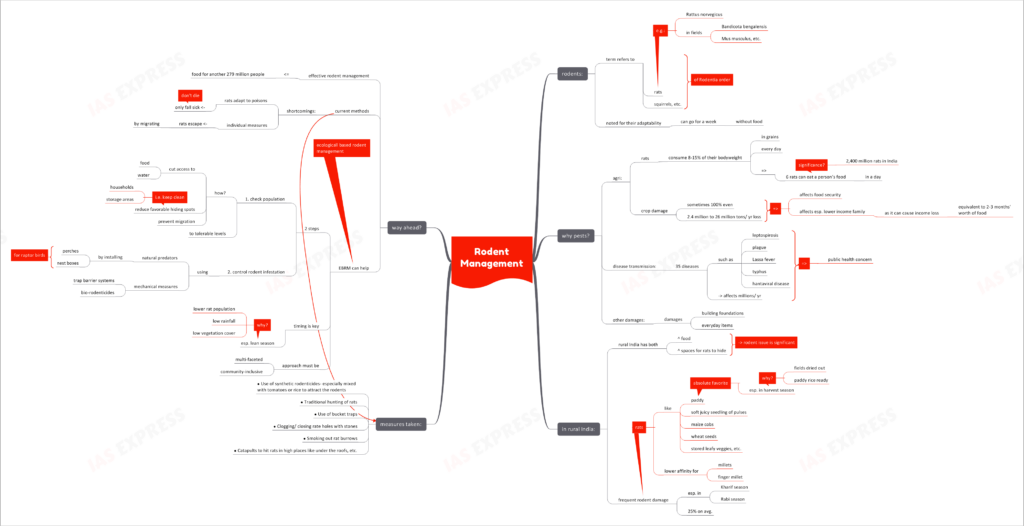Rodent Management- Can EBRM Provide a Solution?

In the recent months, the UN has been repeatedly raising alarms about the food crises affecting several parts of the world. In a time when food security is being threatened by several factors like climate change, the more traditional threat of pests is also gaining relevance.

This topic of “Rodent Management- Can EBRM Provide a Solution?” is important from the perspective of the UPSC IAS Examination, which falls under General Studies Portion.
Rodents:
- The term rodents refers to rats, squirrels and other related animals of the order ‘Rodentia’.
- Common species of rats in India include house rats (Rattus norvegicus) and field rats (Bandicota bengalensis, Mus musculus, etc.).
- These animals are notable for their adaptability. They can go for up to a week without food.
Why are they considered a pest?
- They are notorious for their role as pests- damaging crops and stored commodities. They can even damage everyday items and building foundations.
- They can consume 8-15% of their bodyweight in grains daily. Some 6 rats can eat a person’s food daily and there are some 2,400 million rats in India.
- Agricultural rockets can even touch 100% due to rodent breakouts. India losses 2.4 million to 26 million tons per year due to rodents.
- The rodent issue is particularly damaging for low income families, for it can cause an income loss equivalent to 2-3 months’ worth of food.
- They are also known to transmit diseases- thus posing a public health concern. They transmit 35 different types of diseases, like Lassa fever, leptospirosis, typhus, hantaviral disease and plague that can infect humans. Millions of people suffer from these diseases every year.
How do rodents affect rural India?
- Rodents are a significant problem in rural India, where much of our food is grown. Food and places to hide- the two most important things for a thriving rodent population- are available in plenty in rural areas.
- Frequent crop damage, due to these pests, is reported during the Kharif and Rabi seasons.
- On average, rats damage 25% of the crops.
- They have special affinity for the soft juicy seedling of pulses, maize cobs, wheat seeds, stored leafy vegetables, etc.
- Paddy is their absolute favourite. Rodent damage usually occurs during the harvest time- when the water in the field is dried out.
- Notably, they have lower affinity for millets and finger millet crops.
How is the issue being solved?
- Use of synthetic rodenticides- especially mixed with tomatoes or rice to attract the rodents
- Traditional hunting of rats
- Use of bucket traps
- Clogging/ closing rate holes with stones
- Smoking out rat burrows
- Catapults to hit rats in high places like under the roofs, etc.
How can EBRM help?
- Effective rodent management would mean enough food for another 279 million people worldwide.
- While the current practices are somewhat effective, there are shortcomings:
- Rodents can built resistance to poisons, thus they would simply fall sick, but not die.
- Most methods are done individually i.e. the rodents can simply move to a neighbouring field/ house
- Here, ecologically-based rodent management can provide a solution:
- The first step is to keep the rodent population in check. This requires management of local environment.
- This calls for checking the rodents’ access to water and food. Notably, rodents can’t survive more than a few days without water.
- Reducing favourable spots for rodents to shelter from predators- which requires households and storage areas to be kept clean
- Preventing migration
- The second step is controlling the rodent infestation by:
- Using natural predators- for this perches and nest boxes can be installed to attract raptor birds
- Using mechanical measures- like trap barrier systems and bio-rodenticides
- A key factor in effective rodent management is timing. The lean season is the best time to implement these measures. This is when the rodent population is lower, rainfall is minimal and the vegetation cover is sparser.
- It is important to adopt a multi-faceted approach that involves the entire community for the measures to be effective.
- The first step is to keep the rodent population in check. This requires management of local environment.
Conclusion:
Rodent-damage to crops and infrastructure is a cost that burdens India every year. Managing rodent population effectively is of significant for India’s public health and food safety. Individual-level traditional methods can get us only so far. The situation calls for integration of EBRM into regenerative agricultural practices.
Practice Question for Mains:
How big of an issue is rodent damage in India? Suggest steps to address the issue. (250 words)

